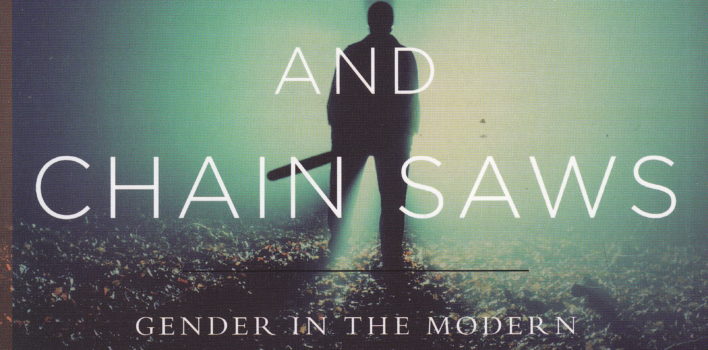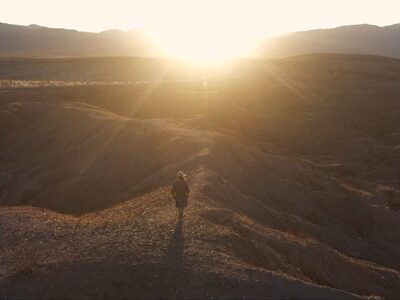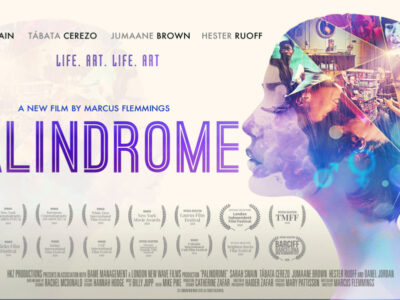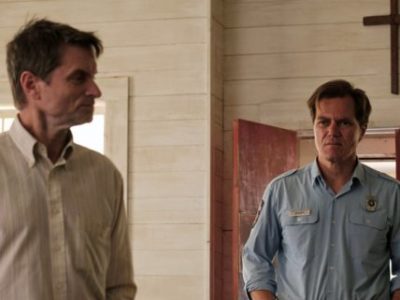Oh! The Horror… | of Slaughtered and Transformed Masculinity
Clearly Rambo (I refer to the general type) has his secure place in popular cinema. That place is not horror, however. If Rambo were to wander out of the action genre into a slasher film, he would end up dead. If he were to wander into an occult film, he would end up reformed–a kinder, gentler man, at last able to marry and communicate openheartedly with his wife, children, parents, and neighbors. Because horror film and action film are both low forms and especially violent, they are commonly linked in the public mind. In many crucial ways, however, they are almost contraries, the former a virtual commentary on the latter. What the action film mystifies, the horror film confesses. If action cinema mourns the passing of the ‘real man,’ horror in general urges it along, and occult films go so far as to imagine a new, revised edition.
– Carol J. Clover, Men, Women, and Chain Saws: Gender in the Modern Horror Film
 Clover’s exploration of slasher and occult horror is paradigm-shifting. The above quote caught my eye within the scope of her overarching argument. She plays with and against gender stereotypes and how they become fluid within the narrative of horror films. Masculinity delineated by machismo–shown prominently within action films of the 80s and 90s–is either slaughtered in slasher films or transformed in occult films.
Clover’s exploration of slasher and occult horror is paradigm-shifting. The above quote caught my eye within the scope of her overarching argument. She plays with and against gender stereotypes and how they become fluid within the narrative of horror films. Masculinity delineated by machismo–shown prominently within action films of the 80s and 90s–is either slaughtered in slasher films or transformed in occult films.
This is something that should be accentuated within Christian understandings of masculinity. There are numerous examples of Christian-penned tomes on “faith-based manliness,” however those I have glanced at seem to be merely Christian-shaded formulations of masculinity already defined within the larger society. As with all things, masculinity, too, should be transformed by the truth claims of the Christian faith. The fact that it hasn’t been, on the whole, means that it still clings to men in our culture as an idol. Clover offers that horror may show a trajectory of the death and transformation of masculinity that parallels the theological conceptions of Christ’s effect on human nature: the death of humanity’s sin and humanity’s sanctification (perfecting) and glorification (full redemption and resurrection), aka transformation.
The Christian faith is a continual cycle of death and transformation. Because Christ died and was glorified (read: transformed into his full being before his followers’ eyes), we, too, die so that we may be transformed. The American conception of masculinity needs to die and be transformed into that which God intended for it to be. Clover’s case in the book makes makes me think that horror may be an unlikely source for the church to challenge cultural definitions/constructions of gender. In slasher films, the macho man will assuredly die at the hands of the slasher villain–a time-honored trope of the sub-genre. Only the “final girl” will eventually turn and fight after she goes through the terror as victim of the slasher villain with a “penetrating” weapon of choice. The final girl then becomes “masculine”-typed in the sense that she becomes the character that men/boys normally identify with in action films. The male gaze then finds its identification with the final girl through the process of victimization by common cinematic feminine stereotypes (death of masculinity) and then that masculinity is transformed: common cinematic masculine stereotypes engendered in a female body.
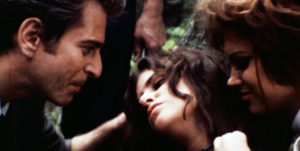 In occult films, Clover makes the argument that there are two stories told in parallel within occult/demonic possession stories. The first story is the possession of the female body by demonic forces (very seldom are men possessed unless they are prepubescent or already “feminized” in some way). Her trajectory is that of becoming the “devil’s portal” according to Clover. An “entry” into the female body leads to demonic control gradually becoming more intense. The second story is the man’s crisis:
In occult films, Clover makes the argument that there are two stories told in parallel within occult/demonic possession stories. The first story is the possession of the female body by demonic forces (very seldom are men possessed unless they are prepubescent or already “feminized” in some way). Her trajectory is that of becoming the “devil’s portal” according to Clover. An “entry” into the female body leads to demonic control gradually becoming more intense. The second story is the man’s crisis:
The quandary of the rational male faced with the satanic or its equivalents is a simple one: should he cling to his rational, scientific understanding of human behavior, or should he yield to the irrational? To that quandary the experience of the troubled woman, however theatrical its manifestation, is largely accessory (pg. 85).
Clover says that the two stories happen in parallel. They intensify and climax at the same moment, however, the woman’s intensity is always a few degrees more. The transformation of masculinity in occult horror must ultimately happen within the constraints of the woman’s story. She goes on:
…I would suggest that the remapping of the masculine in the occult film entails a kind of territorial displacement in the world of gender. I am suggesting, in other words, that the expulsion of the bad masculine–machismo–goes hand in glove with the expansion of the good masculine, the redefined masculine or the “new man”; that this expansion encroaches on and appropriates characteristics traditionally located in the feminine; and that the boundaries of the feminine are correspondingly displaced into territories of distaff excess. Crudely put, for a space to be created in which men can weep without being labeled feminine, women must be relocated to a space where they will be made to wail uncontrollably; for men to be able to relinquish emotional rigidity, control, women must be relocated to a space in which they will undergo a flamboyant psychotic break; and so on. (pg. 104-105)
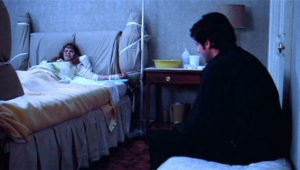 In other words, in both slasher and occult horror, the male gaze’s transformation–and the subsequent convolution of what masculinity means–happens within the overarching movement of the feminine story whether as “final girl” or “possessed woman/girl.” While this betrays the all-too-common criticism of sadistic violation of women in the 80s that came from reviewers like Siskel & Ebert (because of the camera and audience’s ultimate identification with the victim and not the perpetrators), Clover points out the automatic catch-22 of this element. She says that in both types of horror, the female doesn’t actually matter as much as the male, but, instead, is used as a means for the transformation of masculinity. The hope is that the “sacrifice” or the “masculinization” of the feminine story leads to the actual death and resurrection of masculinity. A masculinity renewed–not the common American conception of manliness as machismo–perhaps, looking more feminine within Clover’s conceptual framework.
In other words, in both slasher and occult horror, the male gaze’s transformation–and the subsequent convolution of what masculinity means–happens within the overarching movement of the feminine story whether as “final girl” or “possessed woman/girl.” While this betrays the all-too-common criticism of sadistic violation of women in the 80s that came from reviewers like Siskel & Ebert (because of the camera and audience’s ultimate identification with the victim and not the perpetrators), Clover points out the automatic catch-22 of this element. She says that in both types of horror, the female doesn’t actually matter as much as the male, but, instead, is used as a means for the transformation of masculinity. The hope is that the “sacrifice” or the “masculinization” of the feminine story leads to the actual death and resurrection of masculinity. A masculinity renewed–not the common American conception of manliness as machismo–perhaps, looking more feminine within Clover’s conceptual framework.
Within the scope of these films, masculinity looks significantly different, because of horror’s identification with the victim, which is traditionally understood in cinema as the location of the “damsel in distress,” a feminine typology. Now, I do not know enough, personally, to weigh in on Clover’s arguments and how they would shift the cultural definitions of masculinity (or if horror film would even have that power), but I find her process of re-evaluating gender to be refreshing. Depending on how one reads Clover’s arguments, one could take a pessimistic understanding by saying that all these horror films really do is make the focus on masculinity more subtle through the use of the feminine story/body (which ultimately means the male is still priority) or one could take a more positive view and see that the power of shifting cultural definitions of masculinity lies within the realm of the feminine story/body. That women, ultimately, hold the key to reformulating masculinity. Those two readings are basically two sides of the same coin.
Where I think Clover’s gender gauntlet might be able to help the church, universal, to understand the complexities of gender–and the inequalities systematically present in American society–is in the trajectory of death and transformation of their understandings of gender, significantly its operating conception of masculinity. The American church’s understanding of gender theory should be more complex and thoughtful than just a Christian-coated version of our social gender constructs/definitions. The social understanding needs to die at the foot of the cross so that it can be transformed into that which the faith views as a fully developed understanding of gender.This definition of gender should be significantly different looking than the world’s and it should entail the value of each individual person no matter how they identify.
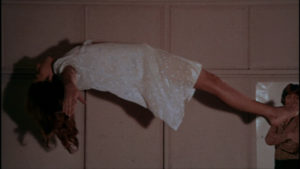 Horror, then, might be able to give the church some insights into how to question and challenge the social gender definitions/constructions of our day. However, for the Christian, our understanding must be primarily filtered through the cross of Christ. It’s really no surprise that what took place on the cross was not too far removed from the gore and violence of slashers and the conquering of demonic powers found in occult films. If Christ’s crucified body is the starting point for the transformation of the world back to what God intended, then the “body horror” of the cross may have more to say about the redeeming of gender than many Americans may want to believe. It, at least, causes me to question those moments of my own thinking about masculinity that are based on the authority of the world, instead of the one who can and will make all things new.
Horror, then, might be able to give the church some insights into how to question and challenge the social gender definitions/constructions of our day. However, for the Christian, our understanding must be primarily filtered through the cross of Christ. It’s really no surprise that what took place on the cross was not too far removed from the gore and violence of slashers and the conquering of demonic powers found in occult films. If Christ’s crucified body is the starting point for the transformation of the world back to what God intended, then the “body horror” of the cross may have more to say about the redeeming of gender than many Americans may want to believe. It, at least, causes me to question those moments of my own thinking about masculinity that are based on the authority of the world, instead of the one who can and will make all things new.


